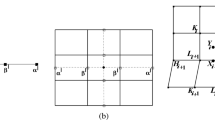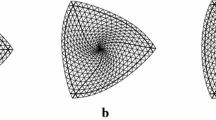Abstract
In this paper, we present a method for constructing Loop’s subdivision surface patches with given \(G^1\) boundary conditions and a given topology of control polygon, using several fourth-order geometric partial differential equations. These equations are solved by a mixed finite element method in a function space defined by the extended Loop’s subdivision scheme. The method is flexible to the shape of the boundaries, and there is no limitation on the number of boundary curves and on the topology of the control polygon. Several properties for the basis functions of the finite element space are developed.









Similar content being viewed by others
References
Bajaj, C., Xu, G., Warren, J.: Acoustics scattering on arbitrary manifold surfaces. In: Proceedings of Geometric Modeling and Processing, Theory and Application, Japan, pp. 73–82 (2002)
Biermann, H., Levin, A., Zorin, D.: Piecewise-smooth subdivision surfaces with normal control. In: SIGGRAPH, pp. 113–120 (2000)
Bryant, R.: A duality theorem for Willmore surfaces. J. Diff. Geom. 20, 23–53 (1984)
Catmull, E., Clark, J.: Recursively generated B-spline surfaces on arbitrary topological meshes. Comput. Aided Des. 10(6), 350–355 (1978)
Clarenz, U., Diewald, U., Dziuk, G., Rumpf, M., Rusu, R.: A finite element method for surface restoration with boundary conditions. Comput. Aided Geom. Des. 21(5), 427–445 (2004)
Clarenz, U., Diewald, U., Rumpf, M.: Anisotropic geometric diffusion in surface processing. In Proceedings of Viz 2000, IEEE Visualization, Salt Lake City, Utah, pp. 397–405 (2000)
do Carmo, M.P.: Riemannian Geometry. Birkhäuser, Boston (1992)
Doo, D., Sabin, M.: Behavious of recursive division surfaces near extraordinary points. Comput. Aided Des. 10(6), 356–360 (1978)
Dyn, N., Levin, D., Gregory, J.A.: A butterfly subdivision scheme for surface interpolation with tension control. ACM Trans. Graph. 9(2), 160–169 (1990)
Epstein, C.L., Gage, M.: The curve shortening flow. In: Chorin, A., Majda, A. (eds.) Wave Motion: Theory, Modeling, and Computation, pp. 15–59. Springer, New York (1987)
Escher, J., Simonett, G.: The volume preserving mean curvature flow near spheres. Proc. Am. Math. Soc. 126(9), 2789–2796 (1998)
Jin, W., Wang, G.: Geometric modeling using minimal surfaces. Chin. J. Comput. 22(12), 1276–1280 (1999)
Kobbelt, L., Hesse, T., Prautzsch, H., Schweizerhof, K.: Iterative mesh generation for FE-computation on free form surfaces. Eng. Comput. 14, 806–820 (1997)
Kuwert, E., Schätzle, R.: The Willmore flow with small initial energy. J. Diff. Geom. 57(3), 409–441 (2001)
Kuwert, E., Schätzle, R.: Gradient flow for the Willmore functional. Commun. Anal. Geom. 10(5), 1228–1245 (2002)
Loop, C.: Smooth Subdivision Surfaces Based on Triangles. Master’s thesis. Technical report, Department of Mathematices, University of Utah (1978)
Man, J., Wang, G.: Approximating to nonparameterzied minimal surface with B-spline surface. J. Softw. 14(4), 824–829 (2003)
Man, J., Wang, G.: Minimal surface modeling using finite element method. Chin. J. Comput. 26(4), 507–510 (2003)
Mullins, W.W.: Two-dimensional motion of idealised grain boundaries. J. Appl. Phys. 27, 900–904 (1956)
Mullins, W.W.: Theory of thermal grooving. J. Appl. Phys. 28, 333–339 (1957)
Peters, J., Reif, U.: The simplest subdivision scheme for smoothing polyhedra. ACM Trans. Graph. 16(4), 420–431 (1997)
Saad, Y.: Iterative Methods for Sparse Linear Systems, 2nd edn. SIAM, Philadelphia, PA (2003)
Sapiro, G.: Geometric Partial Differential Equations and Image Analysis. Cambridge University Press, Cambridge, MA (2001)
Sapiro, G., Tannenbaum, A.: Area and length preserving geometric invariant scale-spaces. IEEE Trans. Pattern Anal. Mach. Intell. 17, 67–72 (1995)
Schneider, R., Kobbelt, L.: Generating fair meshes with \(G^{1}\) boundary conditions. In: Geometric Modeling and Processing, Hong Kong, China, pp. 251–261 (2000)
Schneider, R., Kobbelt, L.: Geometric fairing of irregular meshes for free-form surface design. Comput. Aided Geom. Des. 18(4), 359–379 (2001)
Schweitzer, J. E.: Analysis and Application of Subdivision Surfaces. PhD thesis, Department of Computer Science and Engineering, University of Washington, Seattle (1996)
Simon, L.: Existence of surfaces minimizing the Willmore functional. Commun. Anal. Geom. 1(2), 281–326 (1993)
Stam, J.: Fast evaluation of loop triangular subdivision surfaces at arbitrary parameter values. In SIGGRAPH ’98 Proceedings, CD-ROM Supplement (1998)
Xu, G.: Interpolation by loop’s subdivision functions. J. Comput. Math. 23(3), 247–260 (2005)
Xu, G.: Geometric Partial Differential Equation Methods in Computational Geometry. Science Press, Beijing (2008)
Xu, G., Pan, Q., Bajaj, C.: Discrete surface modelling using partial differential equations. Comput. Aided Geom. Des. 23(2), 125–145 (2006)
Xu, G., Zhang, Q.: \(G^2\) surface modeling using minimal mean-curvature-variation flow. Comput. Aided Des. 39(5), 342–351 (2007)
Zorin, D., Schröder, P., Sweldens, W.: Subdivision for meshes with arbitrary topology. In: SIGGRAPH ’96 Proceedings, pp. 71–78 (1996)
Acknowledgments
Guoliang Xu was supported in part by NSFC Funds for Creative Research Groups of China (Grant No. 11021101, 11321061). Qing Pan was supported by a National Natural Science Foundation of China (Grants No. 11171103) and Scientific Research Fund of Hunan Provincial Education Department (No. 12K029).
Author information
Authors and Affiliations
Corresponding author
Rights and permissions
About this article
Cite this article
Xu, G., Pan, Q. Design of Loop’s Subdivision Surfaces by Fourth-Order Geometric PDEs with \(G^1\) Boundary Conditions. J Sci Comput 62, 674–692 (2015). https://doi.org/10.1007/s10915-014-9872-7
Received:
Revised:
Accepted:
Published:
Issue Date:
DOI: https://doi.org/10.1007/s10915-014-9872-7




